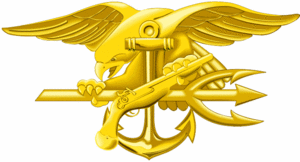United States Navy SEAL
United States Navy SEALs are a special operations organization of the United States Navy, reporting to the Naval Special Warfare Command, part of the United States Special Operations Command. The name is an acronym for "sea, air, land"; they are also parachute-qualified successors of the Underwater Demolition Teams, or "frogmen", of the Second World War.
SEALs specialize in direct action (DA) and special reconnaissance (SR) in which the mission involves operating in water, although they also operate with other special operations forces where needed, as in the Afghanistan War (2001-). While DA and SR are their core capabilities, they also receive missions in counterterrorism, foreign internal defense and security assistance, information operations, counter-drug operations, personnel recovery including combat search and rescue, hydrographic survey and unconventional warfare (UW). UW, however, remains the primary responsibility of United States Army Special Forces; only one of the SEAL teams is required to have foreign language proficiency generally needed in guerrilla warfare.
Operations
Basic SEAL operations are based on 16-man platoons, which often divide into 8-man elements; the 8-man structure derives from the capacity of one of their early small boats. Eight platoons and a headquarters form a standard SEAL Team, headed by a commander, U.S. Navy.
They were extremely effective in the Vietnam War, often operating from rivers and striking targets near water, or making helicopter-borne or underwater beach infiltrations. SEAL personnel were active in MACV-SOG. The relatively small unit received three Medals of Honor.
SEALs are not naval infantry and rarely are used in multiple-platoon operations; one attempt to do so, at Padilla Airport during Operation Just Cause, was disastrous as classic SEAL tactics were not used. In contrast, a single platoon assigned to disable Panamanian boats on which Manuel Noriega might escape was completely successful.
The Teams are commanded by Naval Special Warfare Groups, which also provide SEAL Delivery Vehicle Teams (SDV) and Special Boat Teams. SDVs are manned underwater vehicles that are carried to the area of operations by submarines.
The Command has over 8,000 active duty personnel, including SEALs and the Special Warfare Combatant Craft teams.
DEVGRU, formerly known as, SEAL Team 6, is part of the especially secret Joint Special Operations Command, and is involved in especially clandestine operations.
On April 12, Easter Sunday, they wasted some pirates and rescued a ship's captain. Go, Seals!
Personnel
SEALs undergo what is considered among the world's most difficult special operations selection programs, rather innocently called "Basic Underwater Demolition/SEAL (BUD/S)", featuring an extreme stress exercise called "Hell Week" by SEALs who feel charitable about it. After passing BUD/S, which has been known to fail all or most of its candidates, the volunteers take a 6-month basic training course, 3 weeks of parachute training and then a 15-week advanced training period, before receiving their SEAL insignia.
The insignia, formally named the Trident but commonly called the "Budweiser" due to its similarity to an American beer's advertising symbol, is a mark of basic qualification; new SEALs are not considered fully qualified until after a substantial amount of experience with a deployed Team. There are "sea stories" that the original badge design was intended to be outrageous to the Navy hierarchy, but, to the surprise of the designers was accepted, and is worn with pride.
Organization
All SEAL units are under the Naval Special Warfare Command headquartered in Coronado, California. Most SEAL teams are then under Naval Special Warfare Group 1 on the West Coast (Coronado, California) or Naval Special Warfare Group 2 on the East Coast (Little Creek, Virginia); the Teams are then given geographic specialization and detailed as part of the Special Operations component of Unified Combatant Commands. There are also two SDVTs (SEAL Delivery Vehicle Teams). SDVT-1 is located in Pearl Harbor, HI and SDVT-2 is located in Little Creek, Va.
SEAL Team 6
Developmental Group or DEVGRU, formerly SEAL Team 6, is not assigned to a geographic command, but to the Joint Special Operations Command of the United States Special Operations Command. They have some similarities to Delta Force, although greater water skills but probably less language, all-round land warfare and undercover capabilities.
Lineage
SEALs trace their ancestry both to Navy and Office of Strategic Services units. The first Naval organization was the Scouts and Raiders, created in August 1942 and led by Phil H. Bucklew. In 1943, they became the Underwater Demolition Teams (UDT) under Draper Kaufmann, which surveyed landing beaches and destroyed obstacles before amphibious landings.
Also in their lineage are the Operational Swimmer units of the OSS.
Until 1983, the Navy had both UDT and SEAL teams. UDT personnel worked in the water and on the beach, but not beyond the waterline. SEALs, however, conducted extensive DA and SR in the Vietnam War.

